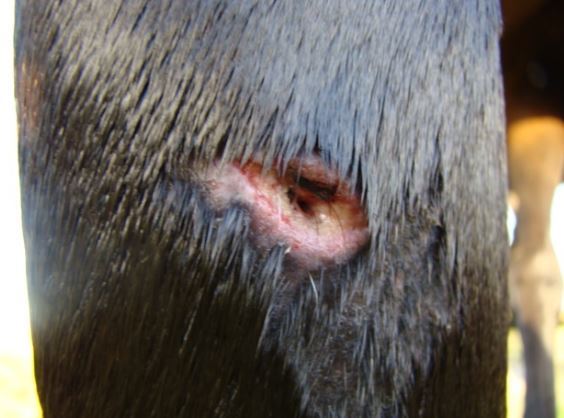Puncture wounds can be tricky—what may look like an innocuous, small cut can rapidly become an infected, time-consuming injury if the wound turns out to be more than surface-deep.
By Sarah E. Coleman

Small cuts, especially on hairy horse legs, can be easy to overlook. Though the majority of us run our hands down our horse’s legs when we see them, it’s easy to pass right over a small cut thinking it’s not a big deal. However, these seemingly small nicks can turn into something more serious in a hurry, turning the injuries into swollen, inflamed areas that are hot to the touch and infected.
Puncture wounds anywhere are cause for concern, but those on the lower legs are especially troublesome as they can be deep enough to involve vital structures. Additionally, puncture wounds can be fatal if they strike vital organs like the heart or brain—or if they damage too deeply inside the hoof capsule.
So what should you do if you find a puncture wound? First and foremost, call your veterinarian. Puncture wounds are usually much more serious than they appear, so getting expert attention soon after discovering it can put your horse on the fast track to healing.
Next, you can:
- Clean around the injury carefully with water, but don’t spray the area directly with a hose as this will force surrounding dirt deeper into the puncture, worsening the chance of infection. Avoid caustic cleaners, but scrubbing gently with saline is appropriate. DO NOT apply pressure to a puncture wound.
- Determine if the wound is near a critical structure such as a tendon sheath or internal organ. While the injury may seem far away from the joint, it’s important to remember that infection can spread rapidly and reach the joint capsule.
- Cover the area in a water-soluble wound product.
- Clip the hair around the affected area, if possible. This will make it easier to see exactly what is going on.
- Apply a clean bandage to the area.
- Double check that your horse is up-to-date on his tetanus vaccine.
If you find your horse with an object embedded n his body, leave it in place. This is especially critical if the object is protruding from your horse’s hoof; an X-ray may be necessary to determine the extent of the injury.
How to Prevent Puncture Wounds

While it’s impossible to protect your horse from all injury, there are some ways you can help prevent puncture wounds. The include:
- Look over stalls and run-in sheds a few times a year, looking for protruding nails or screws.
- Replace broken fence boards as soon as possible; many times nails stick out from broken boards and posts.
- Keep a timely farrier schedule. The nails from lost shoes are a common source of puncture wounds in the soles of hooves.
- Put down a tarp or drop cloth to catch nails or screws when working on projects around the farm.
- Run a magnet through the aisle or grooming area once your farrier is done to pick up any stray nails.
